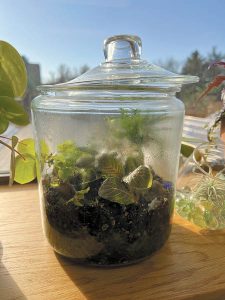February 1, 2024
Yard and Garden: Building and Caring for a Terrarium
Snowy afternoons make an ideal time to construct a terrarium
By Aaron J. Steil
Iowa State University
Consumer Horticulture Extension Specialist
Constructing a terrarium is easy and inexpensive and can be accomplished on a snowy afternoon. Their care is minimal since they can go for months without water under the proper conditions. In addition, a wide variety of plants can be grown that would typically fail miserably in the dry, drafty environment of the average home. In this article, Iowa State University Extension and Outreach horticulture specialists answer questions on creating and caring for your own terrarium.
What is a terrarium?
Terrariums are closed transparent glass or plastic containers that create a mini-environment or ecosystem for plants.
The principle behind a terrarium is simple. The water from the soil is taken up into the plant as it grows and is released through the leaves via transpiration. This water condenses on the glass and returns to the soil where it can be used again. Because this mini water cycle occurs inside the sealed terrarium, the plants can go for months without watering.
It also creates a jungle-like atmosphere of high humidity, warm temperatures and no drafts, which are perfect conditions for many of the tropical-native houseplants common in homes.

Terrarium in a small glass container with lid open to eliminate excess moisture (Aaron Steil, ISU Extension)
How do I build a terrarium?
Start with a clean, dry container. Terrariums can be purchased at many stores, but any closed or semi-closed transparent container, such as a 10-gallon fish tank or large glass jar, has the potential to become a terrarium. Place a 2-inch layer of gravel, pebbles or perlite on the bottom of the container to provide a space for excess water to collect. Next, add a quarter-inch layer of charcoal to help control soil odors. Finally, add 1 to 4 inches of light, well-drained potting soil.
To plant a terrarium, remove the plant from the pot, gently shake off excess soil, and place it in the soil inside the terrarium. Often, a large portion of the root ball must be loosened or removed to allow the plant to fit in the small space. A general rule of thumb when designing a terrarium is to choose an upright-growing, trailing and intermediate-sized plant. Rocks, marbles and other non-biodegradable decorations can be added for a touch of fun.
Once planted, moisten the soil by misting heavily or using a rubber bulb sprinkler. Soil stuck to the glass from planting can be rinsed off by lightly running water down the glass. Finish by covering with the lid.
How do I care for a terrarium?
Place the terrarium in medium to bright, indirect sunlight. An east or north window often works well. Heat can build up quickly when light is too intense, so avoid locations that get direct sunlight.
Fertilizer should be avoided because it will encourage abundant growth and earlier crowding of the plants. If plants exhibit symptoms of low fertility, fertilize with a balanced all-purpose fertilizer with low numbers in the fertilizer analysis (like 10-10-10 or 4-4-4) mixed at quarter-strength.
Check on the terrarium every few weeks and add water when the soil becomes dry. Water will only be needed for many closed terrariums every three to six months, although the frequency can vary greatly based on soil type, plant species, light levels and other factors. If excessive condensation builds up on the glass, uncover the terrarium until some condensation evaporates; then replace the cover.
Over time, plants will begin to outgrow their space. Prune back plants as needed to keep the plants looking good. When plants become too unruly or large, pull them out and replace with something else. No plant can be a permanent addition to a terrarium as they will eventually outgrow the space. Have fun and use it as an opportunity to change things up and try new plants.
What plants grow well in a terrarium?
Indoor tropical plants with slow growth rates, tolerance to high humidity, and small leaves make good candidates for terrariums. Because the plants will be planted in the same space, all the plants should tolerate the same soil moisture, light levels and other growing conditions.
Great upright plants include sweet flag (Acorus gramineus), holly fern (Cyrtomium falcatum), bird’s nest fern (Asplenium nidus) and peacock plant (Calathea). Midsize plants well suited for terrariums include net plant (Fittonia), flame violet (Episcia), cloak fern (Didymochlaena truncatula), table fern (Pteris), prayer plant (Maranta), radiator plant (Peperomia), begonia (Begonia), maidenhair fern (Adiantum), rabbit’s foot fern (Davallia canariensis), aluminum plant (Pilea) and mini African violet (Saintpaulia). Low or trailing plants to consider include earth star (Cryptanthus sp.), creeping moss (Selaginella), baby’s tears (Helxine soleirolii), strawberry vine (Saxifraga sarmentosa), silver sparkles plant (Pilea glauca) and creeping fig (Ficus pumila).
Aaron J. Steil, Consumer Horticulture Extension Specialist a with Iowa State University Extension, can be reached at 515-294-8953 or www.extension.iastate.edu/news/aaron-j-steil
Filed Under: Featured, Health & Wellness, News
Trackback URL: https://www.50pluslife.com/2024/02/01/yard-and-garden-building-and-caring-for-a-terrarium/trackback/


